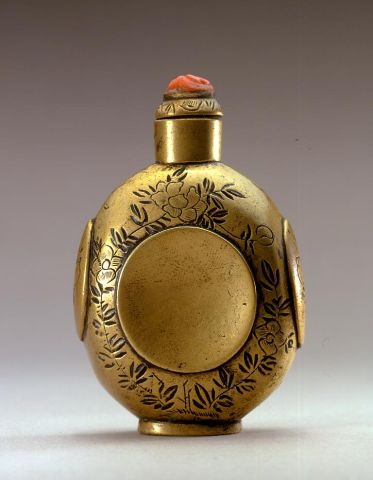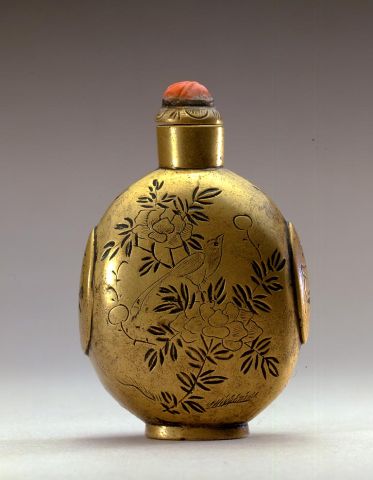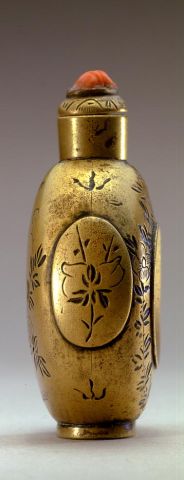


Bottle ID: 424
OVOID WITH PANELS, BIRD, PEONIES
Date: 1653-1900
Height: 61 mm
Bronze, well-patinated, of flattened ovoid form with rounded shoulders sloping to a slightly flaring cylindrical neck, and with a flat oval foot, the narrow sides with raised oval panels, and with on one main side an integral concave "snuff dish", chased with a design surrounding the snuff dish with flowering peonies, the reverse with a bird in the branches of a flowering peony bush, the narrow-side panels each with a spray of two peaches growing from a branch, with a formalized flame above and below the panels, the foot incised with eight characters in eccentric regular script ‘Made by Cheng Rongzhang in the tenth year of the Shunzhi reign.'
Similar Examples:
Crane Collection no. 175.
Sotheby's, New York, September 14, 2010, lot 100, The Joe Grimberg Collection.
Moss, Hugh, Victor Graham and Ka Bo Tsang. A Treasury of Chinese Snuff Bottles - The Mary and George Bloch Collection, 2009, Vol. 7, Part 2, pp. 368-369, no. 1617, and pp. 377-378, no. 1621.
Moss, Hugh, Victor Graham and Ka Bo Tsang. The Art of the Chinese Snuff Bottle - The J & J Collection, 1993, Vol. II, p. 435-436, no. 1621.
Provenance:
Hugh Moss (HK) Ltd.
The Clatworthy Collection
Robert Hall
The White Wings Collection
Edgar and Roberta Wise
Margaret Prescott Wise
Exhibited:
Hong Kong Museum of Art, October - December 1978.
Published:
Hong Kong Museum of Art. Snuff Bottles of the Ch'ing Dynasty, no. 2
Kleiner, Robert. Chinese Snuff Bottles, The White Wings Collection, 1997, pp. 238 - 239, no. 166
It is convenient that the one of the few groups of bottles to be both signed and dated come from the earliest years of snuff taking in China. The arguments over the dating of these 'Cheng Rongzhang' bottles continues to occupy the snuff bottle world. Until the 1970s, this group, mostly decorated with dragons, was considered to be genuine, possibly because no-one really thought about them much at all. As their value escalated the dealers in general remained satisfied as to their authenticity. However researchers such as Emily Byrne Curtis, Prof. Schuyler Cammann, and finally Yang Boda, decided that they were later and probably modern fakes. Yang Boda's lecture at the International Chinese Snuff Bottle Society's convention in Beijing in 1996 laid out clearly his arguments for accepting them as twentieth century fakes. (See Yang Boda, ‘A Study of An Inscribed Cast Bronze Snuff Bottle made During the Reign of Shunzhi by Cheng Rongzhang’ JICSBS, Winter 1996, pp.4-9). However, all of the evidence for their contemporary manufacture can be refuted, and the conclusion that all of this group were made in the 1950s in China is simply incorrect, since there has been one example in the Field Museum of Natural History in Chicago from 1923 and others have been published towards the turn of the 20th century. It is difficult to accept the likelihood of a group of signed and dated bottles existing from the very early years of snuff bottle manufacture. One argument for their authenticity is that the Manchus, newly established at the Palace came from the north, and would have needed a sturdy bottle that could stand up to the rigors of their lives. A bronze bottle would fit within these parameters. However, if this group of bottles are removed from the equation, one is left with the first group of bottles being produced in the Palace Workshops, with the help of Europeans at the Court. This is a far more logical view since it was the Europeans who had, in all likelihood brought snuff into China in the first place. Concurrently, European snuff boxes had been presented to the Court as gifts for the emperors. Metal snuff bottles are few and far between and it is difficult to know where to place the whole group. That being said this example is one of the most dynamic of this group, with its rare fluid subject matter, at once both powerful and delicate.
< Back to full list
 English
English 中文
中文